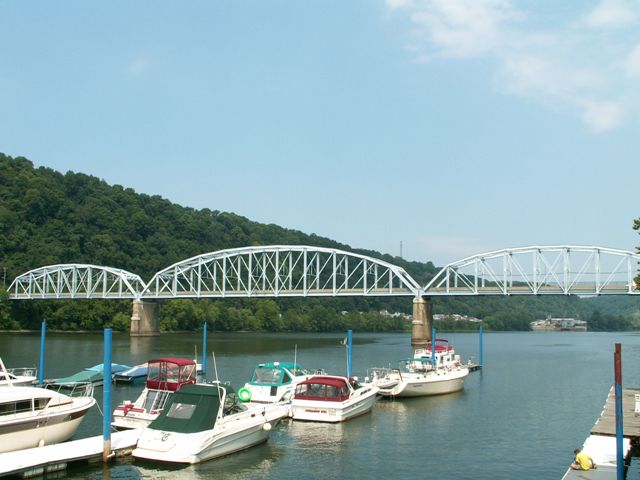We Recommend:
Bach Steel - Experts at historic truss bridge restoration.
New Kensington Bridge
C. L. Schmitt Bridge

Primary Photographer(s): Nathan Holth and Rick McOmber
Bridge Documented: June 12, 2004, August 2007, and July 2, 2014
New Kensington: Allegheny County, Pennsylvania: United States
1927 By Builder/Contractor: American Bridge Company of New York, New York and Engineer/Design: Allegheny County Department of Public Works
1989
370.0 Feet (112.8 Meters)
1,528.0 Feet (465.7 Meters)
27.6 Feet (8.41 Meters)
3 Main Span(s) and 11 Approach Span(s)
21038001000590

View Information About HSR Ratings
Bridge Documentation
View Archived National Bridge Inventory Report - Has Additional Details and Evaluation
This beautiful truss bridge has a Parker configuration, and has three main truss spans, with the middle span being larger than the others. There is also a through plate girder span before the main spans. This bridge is the next bridge upstream from the Hulton Bridge. It is interesting to compare this bridge to the Hulton Bridge, since New Kensington is more of a classic camelback shape, while Hulton exhibits its unusual vertical end posts. This bridge has huge turnbuckles. The bridge is an extremely late example of a pin-connected truss bridge. However, this should not diminish its historic value, especially given the staggering number of large-span truss bridges that have been demolished in Pennsylvania thanks to PennDOT.
Information and Findings From Pennsylvania's Historic Bridge InventoryDiscussion of Bridge The 14 span, 1510'-long, bridge designed and built by the county in 1927 is composed of 3, simply supported, pin connected, Parker thru truss spans (1 @ 370', 2 @ 265') over the river and built-up deck and thru girder approach spans. The trusses are traditionally composed with built up box section for the upper chords and verticals and eye bars for the lower chords and diagonals. The bridge has no innovative or distinctive details other than its overall size, and it is not historically or technologically significant. It is a bridge type and design that was used for major crossings since the late 19th century. The use of pinned connections in 1927 was for ease of fabrication. Discussion of Surrounding Area The bridge carries a 2 lane street and 1 sidewalk over the Allegheny River, active Conrail tracks on both sides of the river, and a portion of SR 1001 on the west side of the river. The railroad lines are the former Pennsylvania Railroad West Penn branch on the east side of the river and its Allegheny Valley branch on the west side. Neither line is historically significant. The area on the east side of the bridge is a mixed use area of industry and warehouses, including a portion of the now-closed Alcoa plant in New Kensington. The area west of the bridge is predominantly late 20th century commercial and light industrial in character. Bridge Considered Historic By Survey: No |
This bridge is tagged with the following special condition(s): Unorganized Photos
![]()
Photo Galleries and Videos: New Kensington Bridge
Bridge Photo-Documentation
A collection of overview and detail photos. This photo gallery contains a combination of Original Size photos and Mobile Optimized photos in a touch-friendly popup viewer.Alternatively, Browse Without Using Viewer
![]()
Additional Unorganized Photos
Original / Full Size PhotosA supplemental collection of photos that are from additional visit(s) to the bridge and have not been organized or captioned. This gallery offers photos in the highest available resolution and file size in a touch-friendly popup viewer.
Alternatively, Browse Without Using Viewer
![]()
Additional Unorganized Photos
Mobile Optimized PhotosA supplemental collection of photos that are from additional visit(s) to the bridge and have not been organized or captioned. This gallery features data-friendly, fast-loading photos in a touch-friendly popup viewer.
Alternatively, Browse Without Using Viewer
![]()
Maps and Links: New Kensington Bridge
Coordinates (Latitude, Longitude):
Search For Additional Bridge Listings:
Bridgehunter.com: View listed bridges within 0.5 miles (0.8 kilometers) of this bridge.
Bridgehunter.com: View listed bridges within 10 miles (16 kilometers) of this bridge.
Additional Maps:
Google Streetview (If Available)
GeoHack (Additional Links and Coordinates)
Apple Maps (Via DuckDuckGo Search)
Apple Maps (Apple devices only)
Android: Open Location In Your Map or GPS App
Flickr Gallery (Find Nearby Photos)
Wikimedia Commons (Find Nearby Photos)
Directions Via Sygic For Android
Directions Via Sygic For iOS and Android Dolphin Browser
USGS National Map (United States Only)
Historical USGS Topo Maps (United States Only)
Historic Aerials (United States Only)
CalTopo Maps (United States Only)


